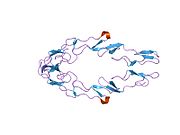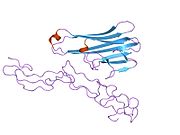گیرنده ۱ فاکتور نکروز تومور
گیرنده ۱ فاکتور نکروز تومور (انگلیسی: Tumor necrosis factor receptor 1) که با نامهای اختصاری TNFR1 و CD120a نیز شناخته میشود، یک پروتئین است که در انسان توسط ژن «TNFRSF1A» کُدگذاری میشود. این گیرنده فاکتور نکروز توموری آلفا (TNFα) متصل میشود.[۴][۵][۶]
عملکرد
[ویرایش]این پروتئین متعلق به ابرخانواده گیرندههای فاکتور نکروز تومور است و در آپوپتوز سلولی و التهاب نقش دارد.
اهمیت بالینی
[ویرایش]جهش در دومِـین خارجسلولی این گیرنده با بروز اختلال ژنتیکی «سندرم تب دورهای وابسته به فاکتور نکروز تومور» مرتبط است.[۷]
جهش در ژن «TNFRSF1A» با افزایش احتمال ابتلا به اماس همراه است.[۸]
سطح سرمی گیرنده ۱ فاکتور نکروز تومور در جریان اسکیزوفرنی و اختلال دوقطبی افزایش مییابد[۹] و هرچه سطح آن بالاتر باشد، دورههای سایکوتیک بیماری شدیدتر است.[۱۰] علاوه بر این، سطح بالای سرمی این گیرنده با اختلالات شناختی و زوال عقل مرتبط است.[۱۱][۱۲]
تعاملات شیمیایی
[ویرایش]گیرنده ۱ فاکتور نکروز تومور با مولکولهای زیر تعامل پروتئین-پروتئین دارد:
- FADD[۱۳][۱۴]
- TRADD[۱۵][۱۴][۱۶][۱۷][۱۸][۱۹][۲۰]
- RIPK1[۱۶][۲۱][۲۲][۱۷][۲۳][۲۴]
- TRAF2[۱۴][۱۶][۱۸]
- فاکتور نکروز توموری آلفا[۲۵][۲۶]
جستارهای وابسته
[ویرایش]منابع
[ویرایش]- ↑ ۱٫۰ ۱٫۱ ۱٫۲ GRCm38: Ensembl release 89: ENSMUSG00000030341 - Ensembl, May 2017
- ↑ "Human PubMed Reference:". National Center for Biotechnology Information, U.S. National Library of Medicine.
- ↑ "Mouse PubMed Reference:". National Center for Biotechnology Information, U.S. National Library of Medicine.
- ↑ Baker E, Chen LZ, Smith CA, Callen DF, Goodwin R, Sutherland GR (November 1991). "Chromosomal location of the human tumor necrosis factor receptor genes". Cytogenet Cell Genet. 57 (2–3): 117–8. doi:10.1159/000133127. PMID 1655358.
- ↑ Schall TJ, Lewis M, Koller KJ, Lee A, Rice GC, Wong GH, Gatanaga T, Granger GA, Lentz R, Raab H, et al. (June 1990). "Molecular cloning and expression of a receptor for human tumor necrosis factor". Cell. 61 (2): 361–70. doi:10.1016/0092-8674(90)90816-W. PMID 2158863. S2CID 36187863.
- ↑ Offermanns, Stefan; Rosenthal, Walter (2008). Encyclopedia of Molecular Pharmacology, Vol. 1 (2nd ed.). Heidelberg, Germany: Springer. p. 1248. ISBN 9783540389163.
- ↑ Kümpfel T, Hohlfeld R (October 2009). "Multiple sclerosis. TNFRSF1A, TRAPS and multiple sclerosis". Nat Rev Neurol. 5 (10): 528–9. doi:10.1038/nrneurol.2009.154. PMID 19794511. S2CID 40665495.
- ↑ International Multiple Sclerosis Genetics Consortium (2011). "The genetic association of variants in CD6, TNFRSF1A and IRF8 to multiple sclerosis: a multicenter case-control study". PLOS ONE. 6 (4): e18813. doi:10.1371/journal.pone.0018813. PMC 3084233. PMID 21552549.
- ↑ Hope S, Melle I, Aukrust P, Steen NE, Birkenaes AB, Lorentzen S, Agartz I, Ueland T, Andreassen OA (November 2009). "Similar immune profile in bipolar disorder and schizophrenia: selective increase in soluble tumor necrosis factor receptor I and von Willebrand factor". Bipolar Disord. 11 (7): 726–34. doi:10.1111/j.1399-5618.2009.00757.x. hdl:10852/34620. PMID 19839997.
- ↑ Hope S, Ueland T, Steen NE, Dieset I, Lorentzen S, Berg AO, Agartz I, Aukrust P, Andreassen OA (April 2013). "Interleukin 1 receptor antagonist and soluble tumor necrosis factor receptor 1 are associated with general severity and psychotic symptoms in schizophrenia and bipolar disorder". Schizophr. Res. 145 (1–3): 36–42. doi:10.1016/j.schres.2012.12.023. PMID 23403415.
- ↑ Buchhave P, Zetterberg H, Blennow K, Minthon L, Janciauskiene S, Hansson O (November 2010). "Soluble TNF receptors are associated with Aβ metabolism and conversion to dementia in subjects with mild cognitive impairment". Neurobiol. Aging. 31 (11): 1877–84. doi:10.1016/j.neurobiolaging.2008.10.012. PMID 19070941. S2CID 34595960.
- ↑ Diniz BS, Teixeira AL, Ojopi EB, Talib LL, Mendonça VA, Gattaz WF, Forlenza OV (2010). "Higher serum sTNFR1 level predicts conversion from mild cognitive impairment to Alzheimer's disease". J. Alzheimers Dis. 22 (4): 1305–11. doi:10.3233/JAD-2010-100921. PMID 20930310.
- ↑ Gajate C, Mollinedo F (2005). "Cytoskeleton-mediated death receptor and ligand concentration in lipid rafts forms apoptosis-promoting clusters in cancer chemotherapy". J. Biol. Chem. 280 (12): 11641–7. doi:10.1074/jbc.M411781200. PMID 15659383.
- ↑ ۱۴٫۰ ۱۴٫۱ ۱۴٫۲ Hsu H, Shu HB, Pan MG, Goeddel DV (1996). "TRADD-TRAF2 and TRADD-FADD interactions define two distinct TNF receptor 1 signal transduction pathways". Cell. 84 (2): 299–308. doi:10.1016/S0092-8674(00)80984-8. PMID 8565075. S2CID 13171355.
- ↑ خطای یادکرد: خطای یادکرد:برچسب
<ref> غیرمجاز؛ متنی برای یادکردهای با نامpmid9915703وارد نشده است. (صفحهٔ راهنما را مطالعه کنید.). - ↑ ۱۶٫۰ ۱۶٫۱ ۱۶٫۲ Hsu H, Huang J, Shu HB, Baichwal V, Goeddel DV (1996). "TNF-dependent recruitment of the protein kinase RIP to the TNF receptor-1 signaling complex". Immunity. 4 (4): 387–96. doi:10.1016/S1074-7613(00)80252-6. PMID 8612133.
- ↑ ۱۷٫۰ ۱۷٫۱ Blankenship JW, Varfolomeev E, Goncharov T, Fedorova AV, Kirkpatrick DS, Izrael-Tomasevic A, Phu L, Arnott D, Aghajan M, Zobel K, Bazan JF, Fairbrother WJ, Deshayes K, Vucic D (2009). "Ubiquitin binding modulates IAP antagonist-stimulated proteasomal degradation of c-IAP1 and c-IAP2(1)". Biochem. J. 417 (1): 149–60. doi:10.1042/BJ20081885. PMID 18939944.
- ↑ ۱۸٫۰ ۱۸٫۱ Shu HB, Takeuchi M, Goeddel DV (1996). "The tumor necrosis factor receptor 2 signal transducers TRAF2 and c-IAP1 are components of the tumor necrosis factor receptor 1 signaling complex". Proc. Natl. Acad. Sci. U.S.A. 93 (24): 13973–8. doi:10.1073/pnas.93.24.13973. PMC 19479. PMID 8943045.
- ↑ Schütze S, Machleidt T, Adam D, Schwandner R, Wiegmann K, Kruse ML, Heinrich M, Wickel M, Krönke M (1999). "Inhibition of receptor internalization by monodansylcadaverine selectively blocks p55 tumor necrosis factor receptor death domain signaling". J. Biol. Chem. 274 (15): 10203–12. doi:10.1074/jbc.274.15.10203. PMID 10187805.
- ↑ Pan G, O'Rourke K, Chinnaiyan AM, Gentz R, Ebner R, Ni J, Dixit VM (1997). "The receptor for the cytotoxic ligand TRAIL". Science. 276 (5309): 111–3. doi:10.1126/science.276.5309.111. PMID 9082980. S2CID 19984057.
- ↑ Kim JW, Choi EJ, Joe CO (2000). "Activation of death-inducing signaling complex (DISC) by pro-apoptotic C-terminal fragment of RIP". Oncogene. 19 (39): 4491–9. doi:10.1038/sj.onc.1203796. PMID 11002422.
- ↑ Duan H, Dixit VM (1997). "RAIDD is a new 'death' adaptor molecule" (PDF). Nature. 385 (6611): 86–9. doi:10.1038/385086a0. hdl:2027.42/62739. PMID 8985253. S2CID 4317538.
- ↑ Newton K, Matsumoto ML, Wertz IE, Kirkpatrick DS, Lill JR, Tan J, Dugger D, Gordon N, Sidhu SS, Fellouse FA, Komuves L, French DM, Ferrando RE, Lam C, Compaan D, Yu C, Bosanac I, Hymowitz SG, Kelley RF, Dixit VM (2008). "Ubiquitin chain editing revealed by polyubiquitin linkage-specific antibodies". Cell. 134 (4): 668–78. doi:10.1016/j.cell.2008.07.039. PMID 18724939. S2CID 3955385.
- ↑ Varfolomeev E, Goncharov T, Fedorova AV, Dynek JN, Zobel K, Deshayes K, Fairbrother WJ, Vucic D (2008). "c-IAP1 and c-IAP2 are critical mediators of tumor necrosis factor alpha (TNFalpha)-induced NF-kappaB activation". J. Biol. Chem. 283 (36): 24295–9. doi:10.1074/jbc.C800128200. PMC 3259840. PMID 18621737.
- ↑ Bouwmeester T, Bauch A, Ruffner H, Angrand PO, Bergamini G, Croughton K, Cruciat C, Eberhard D, Gagneur J, Ghidelli S, Hopf C, Huhse B, Mangano R, Michon AM, Schirle M, Schlegl J, Schwab M, Stein MA, Bauer A, Casari G, Drewes G, Gavin AC, Jackson DB, Joberty G, Neubauer G, Rick J, Kuster B, Superti-Furga G (2004). "A physical and functional map of the human TNF-alpha/NF-kappa B signal transduction pathway". Nat. Cell Biol. 6 (2): 97–105. doi:10.1038/ncb1086. PMID 14743216. S2CID 11683986.
- ↑ Barnhart BC, Peter ME (2003). "The TNF receptor 1: a split personality complex". Cell. 114 (2): 148–50. doi:10.1016/s0092-8674(03)00561-0. PMID 12887914. S2CID 11551587.
- مشارکتکنندگان ویکیپدیا. «Tumor necrosis factor receptor 1». در دانشنامهٔ ویکیپدیای انگلیسی، بازبینیشده در ۲۴ اکتبر ۲۰۲۰.
برای مطالعهٔ بیشتر
[ویرایش]- Rath PC, Aggarwal BB (2000). "TNF-induced signaling in apoptosis". J. Clin. Immunol. 19 (6): 350–64. doi:10.1023/A:1020546615229. PMID 10634209. S2CID 23194856.
- Chen G, Goeddel DV (2002). "TNF-R1 signaling: a beautiful pathway". Science. 296 (5573): 1634–5. doi:10.1126/science.1071924. PMID 12040173. S2CID 25321662.
- Kollias G, Kontoyiannis D (2003). "Role of TNF/TNFR in autoimmunity: specific TNF receptor blockade may be advantageous to anti-TNF treatments". Cytokine Growth Factor Rev. 13 (4–5): 315–21. doi:10.1016/S1359-6101(02)00019-9. PMID 12220546.
- Dodé C, Cuisset L, Delpech M, Grateau G (2003). "TNFRSF1A-associated periodic syndrome (TRAPS), Muckle-Wells syndrome (MWS) and renal amyloidosis". J. Nephrol. 16 (3): 435–7. PMID 12832748.
- Stojanov S, McDermott MF (2007). "The tumour necrosis factor receptor-associated periodic syndrome: current concepts". Expert Reviews in Molecular Medicine. 7 (22): 1–18. doi:10.1017/S1462399405009749. PMID 16216134.
- Rezaei N (2007). "TNF-receptor-associated periodic syndrome (TRAPS): an autosomal dominant multisystem disorder". Clin. Rheumatol. 25 (6): 773–7. doi:10.1007/s10067-005-0198-6. PMID 16447098. S2CID 41808394.
پیوند به بیرون
[ویرایش]- TNFRSF1A protein, human در سرعنوانهای موضوعی پزشکی (MeSH) در کتابخانهٔ ملی پزشکی ایالات متحدهٔ آمریکا
- خلاصهای از اطلاعات ساختاری موجود در بانک داده پروتئین برای یونیپروت: P19438 (Tumor necrosis factor receptor superfamily member 1A) در PDBe-KB.









